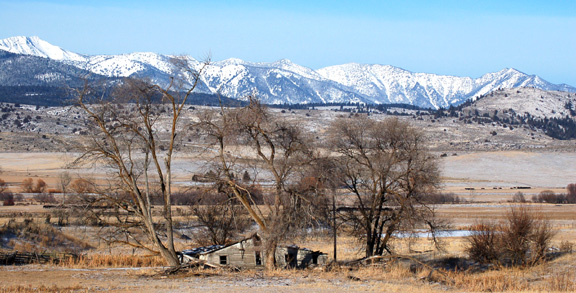It appears that ODFW is carefully wording the messages to the press to indicate that they are not issuing kill permits until adequate non-lethal measures have been seriously implemented. But the bar is ridiculously low if they want it to be, and apparently they are not considering any non-lethal measure that could impact the ranchers financially--like active herding. Are adequate measures being out there with your cows in wolf country, or are adequate measures setting up hit and miss "rag boxes and hollering at wolves from your front door? You may remember that ODFW allowed the killing of two of our Baker County wolves, even though most defensive measures had been removed weeks before the last attacks and the fencing around one of the ranches with lambing areas was pitifully inadequate. See Wolves and Other Predators. One wonders how Hells Canyon Preservation Council could stand by and not oppose those wolf killings. ODFW is apparently willing to sacrifice wolves so that the ranchers don't have to take any more expensive serious defensive measures, and the environmental groups have been stunningly unsuccessful in getting ODFW to put more pressure on ranchers to do more to protect their cattle with non-lethal measures.
I guess ODFW figures that since the ranchers and government eradicated our wolves so that ranchers could put their cows out all over creation with no worries, that they shouldn't have to change their ways now that we want the wolves back. They and others also push the concept of compensating ranchers for losses from wolves.
The double standard is this: Your tax dollars are used by governments to shoot or trap predators like coyotes and now wolves, on private ranch lands, and to fund other protective measures for ranchers, but others are expected to pay for their own measures to protect their property, crops and domestic animals from all wildlife. Some are also pushing for taxpayer funded compensation for rancher losses, but not for the rest of us.
If you ask ODFW to keep the deer out of your garden, they will tell you to put up an expensive 8 foot fence. If the raccoons or foxes come on your property to snack on your chickens, they will tell you to keep a closer eye on your chickens and make a more secure coop. Compensation never comes up. A double standard is in effect re ranchers and wolves.
See below for my questions and answers from ODFW on non-lethal measures, etc.
Livestock Carcasses Litter the Wallowa Landscape
From the Idaho Statesman Article:
"Dennehy says agencies and livestock producers have tried nonlethal deterrents such as removing any livestock carcasses, aerial hazing of wolves and watching livestock more closely." [emphasis added]
The quote from the ODFW spokesperson is that one non-lethal measure the ranchers have taken is to remove livestock carcasses that are attractive to wolves. If so, it is a little late. The private land area of the Imnaha pack was littered with livestock carcasses this spring when a concerned citizen took the following photos. It is reasonable to assume that they attracted wolves to the area when they were relatively fresh, and it gives an indication of careless rancher disposal practices with carcasses. Here are a few of several photos of carcasses in the area of the attacks:



From the ODFW press relase- Third calf killed by wolf in Wallowa County:
"After repeated livestock losses from wolves and use of non-lethal measures, ODFW can issue permits to landowners to kill wolves under certain circumstances."
Wimpy administrative rule:
Oregon Administrative Rules.
(c) Lethal force is allowed by permit from ODFW only if:
(A) ODFW confirms that wolves previously have wounded or killed livestock in the area and efforts to resolve the problem have been deemed ineffective; [emphasis added]
ODFW is being very careful and somewhat vague in their statements referring to which, and to what extent, non-lethal measures are being used.
I tried to speak with Russ Morgan on Monday and Tuesday of this last week, but he did not return my calls. When I pressed one of their spokespeople, Michelle Dennehy, in Salem, about the wolf issues later, after the Wolf Coordinator would not return my calls, this is what she said:
ME-
Also, can you give an a definitive statement about what non-lethal measures were in place prior to the issuance of the 5 kill permits?
Michelle-
"Hazing since early spring (including since early May, a full time hazer), RAG (radio activated guard) boxes on property where it’s appropriate and some ranchers have other telemetry equipment to pick up signals from radio collars if they are in vicinity."
Followup:
ME-
"How many of the ranches where attacks occurred had RAG boxes and telemetry equipment set up?"
Michelle-
"Neither of the two ranches with confirmed wolf depredation had this non-lethal equipment. The area of wolf use is very large and providing this type of equipment to every rancher is not practical or possible. Though it is difficult to predict where depredation might occur, the non-lethal efforts to date have been applied on a number of ranches across the entire area."[Emphasis added]
ME-
"Were any of these latter two measures in place near where the cattle graze or just around the ranch home areas (In other words, where were the boxes and telemetry equipment in relation to the cattle?"
Michelle-
"Yes, these measures are being used where cattle are. However, free ranging cattle are present and are scattered on nearly every piece of land within the upper Wallowa Valley. This makes protection of every cow location impossible. Efforts have been focused to discourage wolf use of these private lands in general but have met with little success – the wolves continue to periodically use the private ranchlands." [Emphasis Added]
Me-
"Who set up these non-lethal measures and are they periodically tested by ODFW to make sure they are working?"
Michelle- "
"ODFW has provided the non-lethal equipment (RAG Boxes and Receivers), and both ODFW, area ranchers, and APHIS-Wildlife services agent have actively monitored and hazed wolves. All equipment is tested and checked. However, it is important to remember that specific non-lethal equipment and techniques are not considered to be effective 100% of the time. Rather they are tools and methods that are designed to help prevent depredation."
More followup:
ME:
"Thanks Michelle.
I gathered from the talk at the "symposium" on Saturday that there is no active herding or baby sitting going on and that ranchers only periodically check on some of their cattle. I assume because you didn't mention active herding as a non-lethal measure being implemented, that your understanding is that it isn't being used.
I look forward to the answers to the "hazer" questions and the one above.
Thanks again,
Chris"
ME:
Michelle, are you going to answer my questions from yesterday? I would also like to know who is paying for the "hazer" and any other non-lethal measures that were being used. Also, when did hazing end, or did it?
Michelle:
"Working on answers for you. Also ODFW Wolf Coordinator Russ Morgan will try and call you in the next few days (not today)." [Call from Morgan didn't happen - Chris]
Michelle: "Re the hazer, better term would be wolf monitoring technician, because what that person is mostly doing is monitoring wolf activity especially during the evening and relaying information on wolf location to area ranchers in an effort to avoid further livestock losses. That position is being paid for out of federal grant funds from the U.S. Fish and Wildlife Service.
Some ranchers have increased their presence around their livestock."
ME:
Thank you for the reply Michelle.
Followup for understanding RE hazer and herding:
Does the wolf monitoring technician work from the air or on the ground?
Does he try to frighten the wolves away with noise and etc, or just monitor their presence?
Who actually employs the technician? Is the technician a wildlife biologist, a rancher's nephew, or what?
What do you mean when you write that "Some ranchers have increased their presence around their livestock."? The statement seems very vague to me. What percentage of them are? To what extent? Are they or hired hands staying out there with the livestock? Do they keep them bunched up with supervision?
I look forward to answers to these questions.
Thank you.
Chris
Michelle:
"I believe wolf monitoring technician works from the ground. An employee of ODFW.. [Emphasis added - Chris
Not sure of the percentage who have increased their presence around livestock and I think the best bet is for you to wait to talk to Russ cause he has more details. If I talk to him today I’ll remind him to call you; I know he was planning to anyway
This has been going on all week. Still no call from Russ Morgan. I guess he's busy cultivating mainstream local media and environmental groups.
Chris











